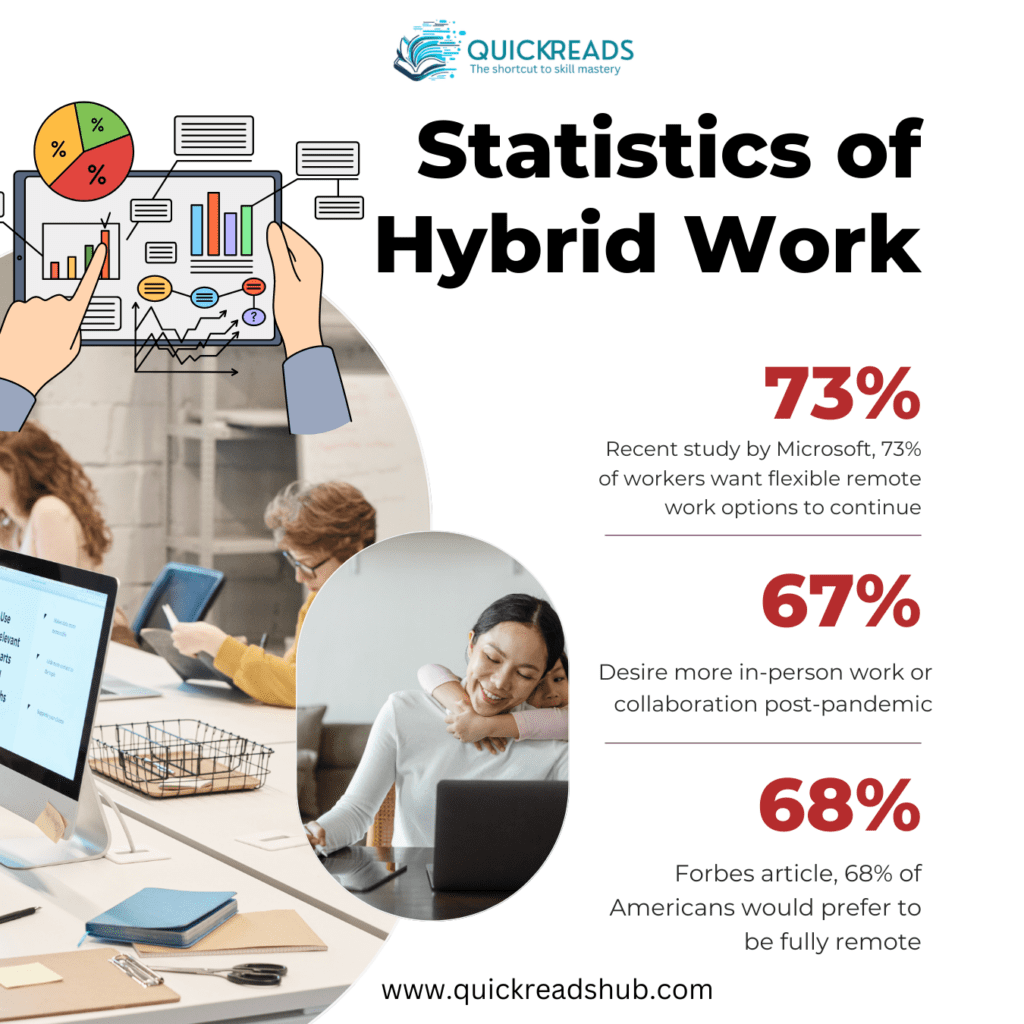Discover the future of hybrid work trends. Learn what you need to know to stay ahead in the evolving workplace. Click to explore more.
Introduction
Alright, let’s dive into the world of hybrid work, a new norm that’s been sweeping across the globe faster than a cat video goes viral. Now, you might be wondering, “Why should I care about hybrid work trends?” Well, my friend, understanding these trends is as crucial as knowing the weather forecast before planning a beach trip.
Before you dive deeper, have you checked out our ‘New Six-figure Remote Work Tips: The Ultimate Treasure Guide’ yet? If not, make sure to give it a read first for a comprehensive understanding of remote work success!
You see, hybrid work is like a tropical island in the vast ocean of employment. It offers the best of both worlds – the comfort of working from home and the camaraderie of the office environment. But just like any island, navigating through it can be tricky without a map. That’s where understanding hybrid work trends comes in. It’s your compass, guiding you through the changing tides of the work landscape.
Now, why should you stick around and read our blog post? Well, it’s simple. We’re offering you a first-class ticket to the island of hybrid work knowledge. We’ve packed this blog with valuable insights, tips, and strategies that will help you sail smoothly in the hybrid work sea. So, buckle up, and let’s set sail on this exciting journey!
The Evolution of Hybrid Work
From Traditional Office Work to Remote Work: A Brief History
Once upon a time, the 9-to-5 grind in an office was the only way we knew how to work. The concept of remote work was as foreign as an alien from Mars. But as technology advanced, the seeds of remote work were sown, and slowly but surely, it started to take root.
The COVID-19 Pandemic: A Catalyst for the Emergence of Hybrid Work
Enter 2020, and the world was hit by the COVID-19 pandemic. It was a curveball that forced us all to adapt. Offices were out, and our homes became our new workstations. This unexpected shift led to the emergence of hybrid work, a blend of remote and in-office work. It was like turning lemons into lemonade!
Technology as the Backbone of Hybrid Work: Facilitating Seamless Transition
Technology played the role of a superhero in this transition. From Zoom meetings to Slack messages, technology tools became our new best friends, making the transition to hybrid work as smooth as a hot knife through butter.
Latest Statistics and Studies on Hybrid Work Evolution
The evolution of hybrid work is not just a trend, but a significant shift backed by data and studies. A report from Accenture revealed that 83% of over 9,000 workers surveyed prefer a hybrid model where they can work remotely at least 25% of the time. High-revenue-growth companies, 63% of them, have already enabled productivity anywhere workforce models, where employees have the option of working remotely or on-site.
Moreover, a study by Prodoscore found that remote workers’ productivity increased by 47% during the lockdown in March and April 2020. Communication activities such as emailing, telephoning, and chat messaging all climbed, indicating that remote work can indeed be effective. Buffer’s 2023 State of Remote Work report found that 91% of survey respondents enjoyed working remotely, with flexibility listed as the biggest benefit.
These statistics and studies show that the evolution of hybrid work is not just a passing phase but a significant shift in how we work. As technology continues to advance and companies see the benefits of hybrid work, this trend is likely to continue and become the new norm in the workplace.
The Current State of Hybrid Work

Hybrid Work in Numbers: Current Statistics and Surveys
Let’s dive into the world of numbers and surveys to get a clearer picture of the current state of hybrid work. According to a recent study by Microsoft, 73% of workers want flexible remote work options to continue, while 67% desire more in-person work or collaboration post-pandemic. This shows a clear preference for a hybrid work model, where employees can enjoy the best of both worlds.
The Win-Win Situation: Benefits of Hybrid Work for Employees and Employers
Hybrid work is like a two-sided coin, with benefits for both employees and employers. For employees, it offers flexibility, better work-life balance, and reduced commuting stress. Imagine being able to work in your pajamas one day and dressing up for an in-person meeting the next. That sounds like a win, right?
On the flip side, employers also reap benefits. They can tap into a wider talent pool, reduce office space costs, and even increase productivity. It’s like having your cake and eating it too!
Overcoming Obstacles: Challenges in Implementing Hybrid Work and How to Address Them
But let’s not sugarcoat it. Implementing hybrid work isn’t a walk in the park. There are challenges to overcome. According to a Forbes article, 68% of Americans would prefer to be fully remote, complicating employer decisions. There’s also the issue of technology challenges, as highlighted by TechTarget.
So, how do we address these challenges? It’s all about flexibility and compromise. Employers need to be open to employees’ preferences and invest in the necessary technology to support remote work. It’s like solving a puzzle, where each piece must fit perfectly to create a complete picture.
Updated Information on the Current State of Hybrid Work
To keep you updated, I’ve scoured the internet for the latest information. According to a Deloitte report, women are reporting more positive experiences with hybrid work. Furthermore, a recent study by Gartner found that 64% of organizations are now using a hybrid work model. This shows that hybrid work is not only feasible but also beneficial for various groups.
So, there you have it! The current state of hybrid work in a nutshell. It’s a dynamic and evolving field, and staying informed is key. Remember, knowledge is power!
Key Hybrid Work Trends

Digital Collaboration Tools: The New Office Essentials
In the hybrid work environment, digital collaboration tools have become as essential as coffee in the morning. They’re the new office essentials, the lifeblood of our daily operations. Think about it: without tools like Slack, Microsoft Teams, or Google Workspace, how would we manage to coordinate with our colleagues from different locations? It’s like trying to bake a cake without a recipe or ingredients. It just doesn’t work.
These tools have become our virtual offices, where we hold meetings, share ideas, and even have those casual water cooler chats. They’ve made it possible for us to continue working seamlessly, regardless of where we are. It’s like having a portable office in our pockets. Isn’t that something?
Employee Well-being in Hybrid Work: A Priority, Not an Option
With the shift to hybrid work, employee well-being has moved from being a nice-to-have to a must-have. It’s no longer just about providing a paycheck, but also about ensuring that employees are healthy, happy, and engaged. And why not? A happy employee is a productive employee, right?
Companies are now offering flexible hours, mental health support, and even virtual fitness classes. It’s like they’ve finally realized that we’re not robots, but humans who need to take care of our physical and mental health. It’s a refreshing change, don’t you think?
Flexibility in Work Arrangements: A Shift Towards Employee-Centric Policies
The days of the rigid 9-to-5 schedule are slowly fading into the background. In its place, we’re seeing a shift towards more flexible work arrangements. It’s like companies have finally realized that one size doesn’t fit all when it comes to work schedules.
Now, employees can choose when and where they work, based on what suits them best. It’s a win-win situation: employees get to maintain a healthy work-life balance, and companies get a more engaged and productive workforce. It’s like having your cake and eating it too!
AI and Automation in Hybrid Work: Enhancing Productivity and Efficiency
AI and automation are no longer just buzzwords. They’re now integral parts of our work processes, helping us to be more productive and efficient. From automating repetitive tasks to providing insights for decision-making, AI and automation are like the superheroes of the hybrid work environment.
But don’t worry, they’re not here to take our jobs. Instead, they’re here to take over the mundane tasks, so we can focus on the more important and creative aspects of our work. It’s like having a personal assistant who never sleeps!
My Personal Experience and Observations on Hybrid Work Trends

Navigating the hybrid work setup in the Philippines, particularly in the wake of the lockdown lift, has been akin to a roller coaster ride, filled with highs and lows. On some days, I find myself reporting to the office, and training colleagues, while on others, I enjoy the comfort of my home office. Despite the challenges, the experience has been largely positive.
The flexibility of oscillating between home and office work has been a boon. It’s like enjoying the best of both worlds. I’ve noticed a surge in my productivity, stemming from the freedom to dictate my work environment and schedule.
However, it’s not always a bed of roses. Feelings of isolation and home distractions pose challenges. But with the right tools and support, these hurdles become manageable.
In conclusion, the hybrid work environment is not just a passing phase; it’s here to stay, revolutionizing our work norms. I’m thrilled to be part of this transformative journey and am eager to see where it leads us. What about you? Are you prepared to embrace the hybrid work trend?
The Future of Hybrid Work
Predictions for the Future of Hybrid Work: What Experts Say
The future of hybrid work is like a kaleidoscope, ever-changing and full of possibilities. Experts predict that the hybrid work model will continue to evolve, with more companies adopting this approach as a long-term strategy. They believe that the flexibility and balance offered by hybrid work will become the new norm, with employees splitting their time between home and the office.
But what does this mean for you? Well, imagine being able to work from your favorite coffee shop in the morning, then heading to the office for a team meeting in the afternoon. Sounds like a dream, right? But remember, it’s not all rainbows and unicorns. There are challenges too, like maintaining a strong company culture and ensuring effective communication3. So, buckle up! The future of hybrid work is going to be an exciting ride.
Technological Advancements and Their Potential Impact on Hybrid Work
Technology is like the secret sauce in the hybrid work recipe. It’s what makes this whole thing possible. From video conferencing tools to project management software, technology is the backbone of hybrid work.
But hold onto your hats, folks, because the future is going to be even more tech-tactic. We’re talking about advancements like AI and machine learning, which could automate routine tasks and free up more time for creative and strategic work. And let’s not forget about virtual and augmented reality. Imagine being able to virtually ‘sit’ next to your colleague in another country during a meeting. Mind-blowing, right?
Leadership in the Future of Hybrid Work: Guiding the Ship in Uncharted Waters
Leading a hybrid team is kind of like being a captain of a ship in uncharted waters. It’s a new territory, and there’s no one-size-fits-all approach. But fear not, brave leaders! Experts suggest that the key to successful leadership in the future of hybrid work lies in empathy, open communication, and flexibility.
Leaders will need to strike a balance between providing flexibility and maintaining a sense of team unity (source). They’ll also need to be tech-savvy, as technology will play a crucial role in managing hybrid teams. So, leaders, it’s time to roll up your sleeves and navigate this new world of work. The future is here, and it’s hybrid!
The future of hybrid work is bright, full of potential, and, let’s be honest, a little bit daunting. But with the right approach, tools, and leadership, we can make it work. After all, who doesn’t love a good work-life balance?
Preparing for the Future of Hybrid Work
Adapting to Hybrid Work Trends: Strategies for Businesses
The hybrid work model is like a new dance craze, and businesses need to learn the steps to keep up. It’s a mix of remote and in-office work, and it’s changing the way we think about the traditional 9-to-5 grind. But how can businesses adapt to this trend?
First, it’s crucial to embrace technology. Just like you wouldn’t go on a road trip without a GPS, you can’t navigate hybrid work without the right tools. Video conferencing software, project management tools, and instant messaging platforms are all essential for keeping teams connected, no matter where they’re working from.
Second, businesses need to rethink their office spaces. It’s kind of like rearranging your living room to make space for a new couch. With fewer employees in the office full-time, businesses can redesign their spaces to better support collaboration and creativity when teams do come together.
Lastly, businesses need to prioritize flexibility. This is like being a yoga instructor, always encouraging your students to stretch a little further. By offering flexible work hours and understanding that everyone’s needs are different, businesses can attract and retain top talent.
Employee Input in Shaping the Future of Work: A Crucial Factor
When it comes to shaping the future of work, employee input is as important as the secret ingredient in your grandma’s famous cookies. Without it, something’s just missing. Employees are the ones on the front lines, after all, and their insights can help businesses understand what’s working and what’s not.
For instance, regular surveys can be a great way to gather feedback. It’s like asking your dinner guests how they liked the meal, so you know what to cook next time. By asking employees about their experiences with hybrid work, businesses can make informed decisions about policies and practices.
The Role of HR in Managing Hybrid Work Arrangements: From Policy Making to Implementation
The role of HR in managing hybrid work arrangements is kind of like being a conductor, guiding the orchestra through a complex piece of music. From policy making to implementation, HR has a crucial role to play.
- First, HR needs to establish clear policies. This is like setting the rules of a board game. Everyone needs to know what’s expected of them, from when and where they’re supposed to work, to how they’re supposed to communicate with their team.
- Next, HR needs to support managers in implementing these policies. This is like being a coach, offering guidance and strategies to help managers lead their teams effectively.
- Finally, HR needs to be there for employees, answering questions and addressing concerns. This is like being a trusted advisor, always ready to provide support and advice.
Sources:
University of Washington
The George Washington University
Conclusion
Recap: The Importance of Understanding and Adapting to Hybrid Work Trends
Well, folks, we’ve been on quite a journey, haven’t we? From the rise of hybrid work to the current state of affairs, we’ve explored the ins and outs of this new work model. It’s like we’ve been on a grand tour of a new city, taking in all the sights and sounds.
Remember, understanding hybrid work trends is not just about keeping up with the times. It’s about preparing for the future. It’s like checking the weather forecast before you head out for a hike. You want to know what’s coming so you can be ready for it.
Embracing the Future of Hybrid Work: A Call to Action for Readers
Now, it’s your turn. It’s time to embrace the future of hybrid work. It’s like standing at the edge of a diving board. You’ve learned all the techniques, you’ve watched others do it, and now it’s your turn to take the plunge.
Don’t be afraid of the changes that are coming. Instead, see them as opportunities. Opportunities to work in new ways, to balance work and life better, to collaborate and innovate.
So, are you ready to dive in? Are you ready to embrace the future of hybrid work and all the opportunities it brings? I hope so, because the future is here, and it’s hybrid.
Remember, the future is not something that just happens to us. It’s something we create. So let’s create a future of work that’s flexible, inclusive, and beneficial for everyone.
And with that, we’ve reached the end of our journey. But remember, this is just the beginning. The future of hybrid work is a story that’s still being written, and you have a role to play in it. So let’s get to work, shall we?





